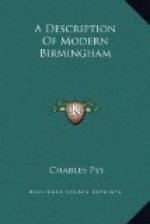This village having for a series of years been celebrated for a spring of saline water, it has for some time become fashionable to resort there. The first baths were erected in the year 1786, now called the Centre well, by Mr. Thomas Abbotts, a native of the place; the beneficial effects of the water having been noticed and recommended by Dr. Kerr, of Northampton, and Dr. Allen. At this time there were two baths, one of them hot and the other cold, which for several years afforded sufficient accommodation for all invalids who resorted there, and were in general lodged at the adjacent cottages, there being no more than two small inns, the Bowling Green and the sign of the Dog.
Dr. Edward Johnstone, of Birmingham, having recommended the use of these waters to several of his patients, the number of visitants increased annually, so that in 1790, Matthew Wise, Esq. caused another well to be opened, now called the Road well, where he erected a range of baths, more spacious than the others, to which was annexed considerably more conveniences, with some pretensions to elegance; but as yet no additional apartments were provided for the accommodation of strangers, except a few more of the cottagers fitting up additional rooms, it being no more than a rural and retired village.
In the year 1794, Dr. Lambe, a physician of eminence, who resided at Warwick, published in the fifth volume of the Memoirs of the Manchester Philosophical Society, an accurate analysis of the Leamington water, by which it appears to possess the same genial influence on the human frame as the water of Cheltenham, which was then rising into celebrity. There was one very material difference between the waters of Leamington and those of Cheltenham, there being at the former place an abundant supply of the mineral water, not only for drinking but for hot and cold bathing; whilst, on the contrary, the saline spring at Cheltenham scarcely produced a sufficient quantity for drinking. The influx of visitors to Leamington now increased with such rapidity, that every cottager exerted himself to fit up lodgings, and every house to which lodgers resorted improved their appearance; in short, new wells were opened, new houses erected, and not only new streets formed in the old town, as it was now called, but a plan was drawn for the erection of a new town, which has within a few years increased in a most astonishing manner.




